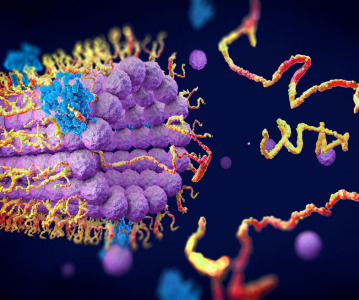High-capacity nanoparticle for targeted cancer therapy

MIT chemists have now shown they can package three or more drugs into a novel type of nanoparticle, allowing them to design custom combination therapies for cancer.
Nanoparticles offer a promising way to deliver cancer drugs in a targeted fashion, helping to kill tumours while sparing healthy tissue. However, most nanoparticles that have been developed so far are limited to carrying only one or two drugs.
MIT chemists have now shown that they can package three or more drugs into a novel type of nanoparticle, allowing them to design custom combination therapies for cancer. In tests in mice, the researchers showed that the particles could successfully deliver three chemotherapy drugs and shrink tumours.
In the same study, the researchers also showed that when drugs are delivered by nanoparticles, they don’t necessarily work by the same DNA-damaging mechanism as when delivered in their traditional form.
That is significant because most scientists usually assume that nanoparticle drugs are working the same way as the original drugs, says Jeremiah Johnson, the Firmenich Career Development Associate Professor of Chemistry and the senior author of the paper. Even if the nanoparticle version of the drug still kills cancer cells, it’s important to know the underlying mechanism of action when choosing combination therapies and seeking regulatory approval of new drugs, he says.
“People tend to take it as a given that when you put a drug into a nanoparticle it’s the same drug, just in a nanoparticle,” Johnson says. “Here, in collaboration with Mike Hemann, we conducted detailed characterization using an RNA interference assay that Mike developed to make sure the drug is still hitting the same target in the cell and doing everything that it would if it weren’t in a nanoparticle.”
The paper’s lead authors are Jonathan Barnes, a former MIT postdoc; and Peter Bruno, a postdoc at MIT’s Koch Institute for Integrative Cancer Research. Other authors are grad students Hung Nguyen and Jenny Liu, former postdoc Longyan Liao, and Michael Hemann, an associate professor of biology and member of the Koch Institute.
Precise control
The new nanoparticle production technique, which Johnson’s lab first reported in 2014, differs from other methods that encapsulate drugs or chemically attach them to a particle. Instead, the MIT team creates particles from building blocks that already contain drug molecules. They can join the building blocks together in a specific structure and precisely control how much of each drug is incorporated.
“We can take any drug, as long as it has a functional group [a group of atoms that allows a molecule to participate in chemical reactions], and we can load it into our particles in exactly the ratio that we want, and have it release under exactly the conditions that we want it to,” Johnson says. “It’s very modular.”
A key advantage is that this approach can be used to deliver drugs that normally can’t be encapsulated by traditional methods.
Using the new particles, the researchers delivered doses of three chemotherapy drugs — cisplatin, doxorubicin, and camptothecin — at concentrations that would be toxic if delivered by injection throughout the body, as chemotherapy drugs usually are. In mice that received this treatment, ovarian tumours shrank and the mice survived much longer than untreated mice, with few side effects.
Unexpected mechanism
Using a method developed by Hemann’s lab, the researchers then investigated how their nanoparticle drugs affect cells. The technique measures cancer drugs’ effects on more than 100 genes that are involved in the programmed cell death often triggered by cancer drugs. This allows scientists to classify the drugs based on which clusters of genes they affect.
“Drugs that damage DNA get clustered into DNA damage-inducing agents, and drugs that inhibit topoisomerases cluster together in another region,” Johnson says. “If you have a drug that you don’t know the mechanism of, you can do this test and see if the drug clusters with other drugs whose actions are known. That lets you make a hypothesis about what the unknown drug is doing.”
The researchers found that nanoparticle-delivered camptothecin and doxorubicin worked just as expected. However, cisplatin did not. Cisplatin normally acts by linking adjacent strands of DNA, causing damage that is nearly impossible for the cell to repair. When delivered in nanoparticle form, the researchers found that cisplatin acts more like a different platinum-based drug known as oxaliplatin. This drug also kills cells, but by a different mechanism: It binds to DNA but induces a different pattern of DNA damage.
The researchers hypothesize that after cisplatin is released from the nanoparticle, via a reaction that kicks off a group known as a carboxylate, the carboxylate group then reattaches in a way that makes the drug act more like oxaliplatin. Many other researchers attach cisplatin to nanoparticles the same way, so Johnson suspects this could be a more widespread issue.
His lab is now working on a new version of the cisplatin nanoparticle that operates according to the same mechanism as regular cisplatin. The team is also developing nanoparticles with different combinations of drugs to test against pancreatic and other types of cancers.
Related News
-
News A Day in the Life of a Start-Up Founder and CEO
At CPHI we work to support Start-Up companies in the pharmaceutical industry and recognise the expertise and innovative angles they bring to the field. Through our Start-Up Programme we have gotten to know some of these leaders, and in this Day in the ... -
News Biopharmaceutical manufacturing boost part of new UK government budget
In their national budget announced by the UK Labour Party, biopharmaceutical production and manufacturing are set to receive a significant boost in capital grants through the Life Sciences Innovative Manufacturing Fund (LSIMF). -
News CPHI Podcast Series: The power of proteins in antibody drug development
In the latest episode of the CPHI Podcast Series, Lucy Chard is joined by Thomas Cornell from Abzena to discuss protein engineering for drug design and development. -
News Amgen sues Samsung biologics unit over biosimilar for bone disease
Samsung Bioepis, the biologics unit of Samsung, has been issued a lawsuit brought forth by Amgen over proposed biosimilars of Amgen’s bone drugs Prolia and Xgeva. -
News CPHI Podcast Series: Why we need to consider women in clinical trials
The latest episode of the CPHI Podcast Series with Lucy Chard covers women's health, specifically women's representation in clinical trials, the associated bias, and the impacts on health for this population. -
News US FDA does not approve MDMA therapy for PTSD, requests more data
The MDMA-based therapeutic developed by Lykos Therapeutics, a California-based Public Benefit Corporation (PBC), has been reviewed and unapproved by the US FDA. The regulator has requested additional phase III trial data for further safety and efficacy... -
News Novartis and Viatris latest facing lawsuit over HeLa cell misuse
Global pharmaceutical companies Novartis and Viatris are the latest hit with a lawsuit claim pertaining to alleged misuse of the ‘HeLa’ cell line from the estate of woman whose cancerous tissue cells were taken without consent. -
News Sanofi invests billions into Frankfurt insulin production site
French pharmaceutical company Sanofi have announced an investment of EUR1.3 billion at their existing BioCampus site in Frankfurt am Main for the expansion of insulin production.
Position your company at the heart of the global Pharma industry with a CPHI Online membership
-
Your products and solutions visible to thousands of visitors within the largest Pharma marketplace
-
Generate high-quality, engaged leads for your business, all year round
-
Promote your business as the industry’s thought-leader by hosting your reports, brochures and videos within your profile
-
Your company’s profile boosted at all participating CPHI events
-
An easy-to-use platform with a detailed dashboard showing your leads and performance



.png)

.png)
.png)
.png)